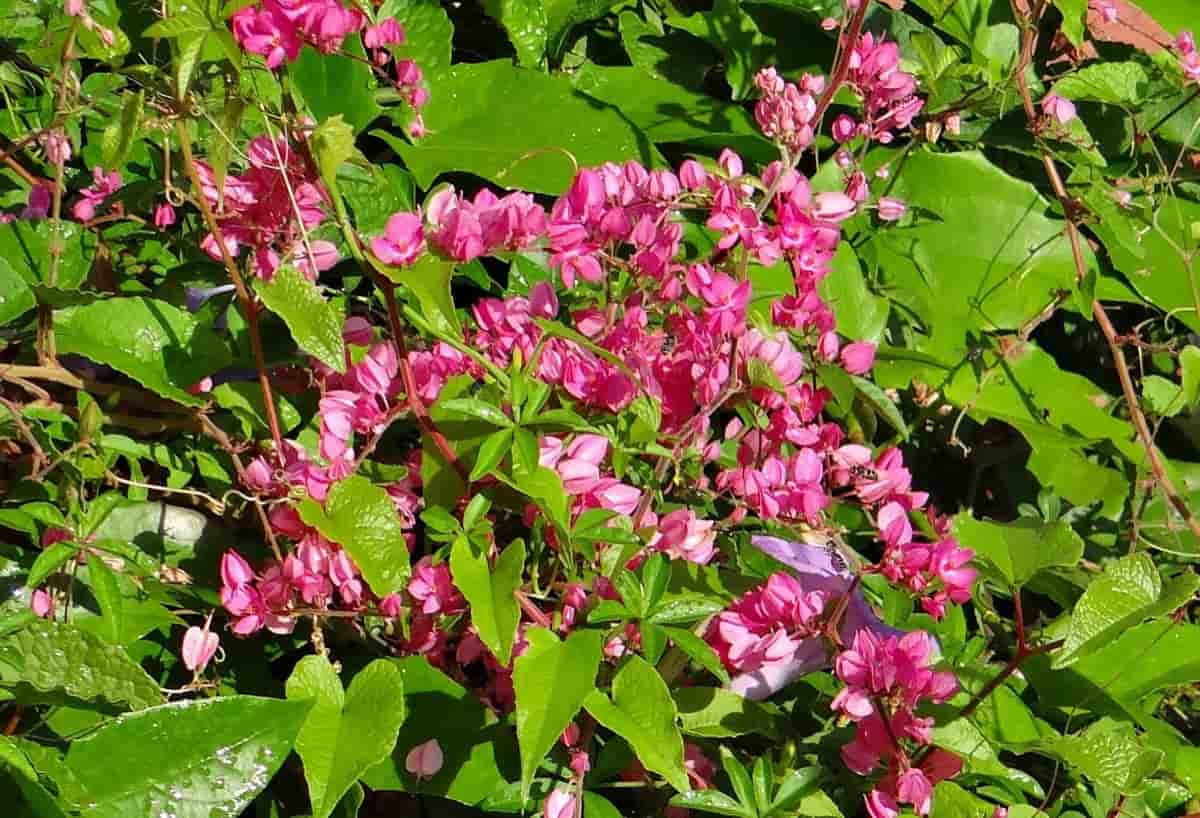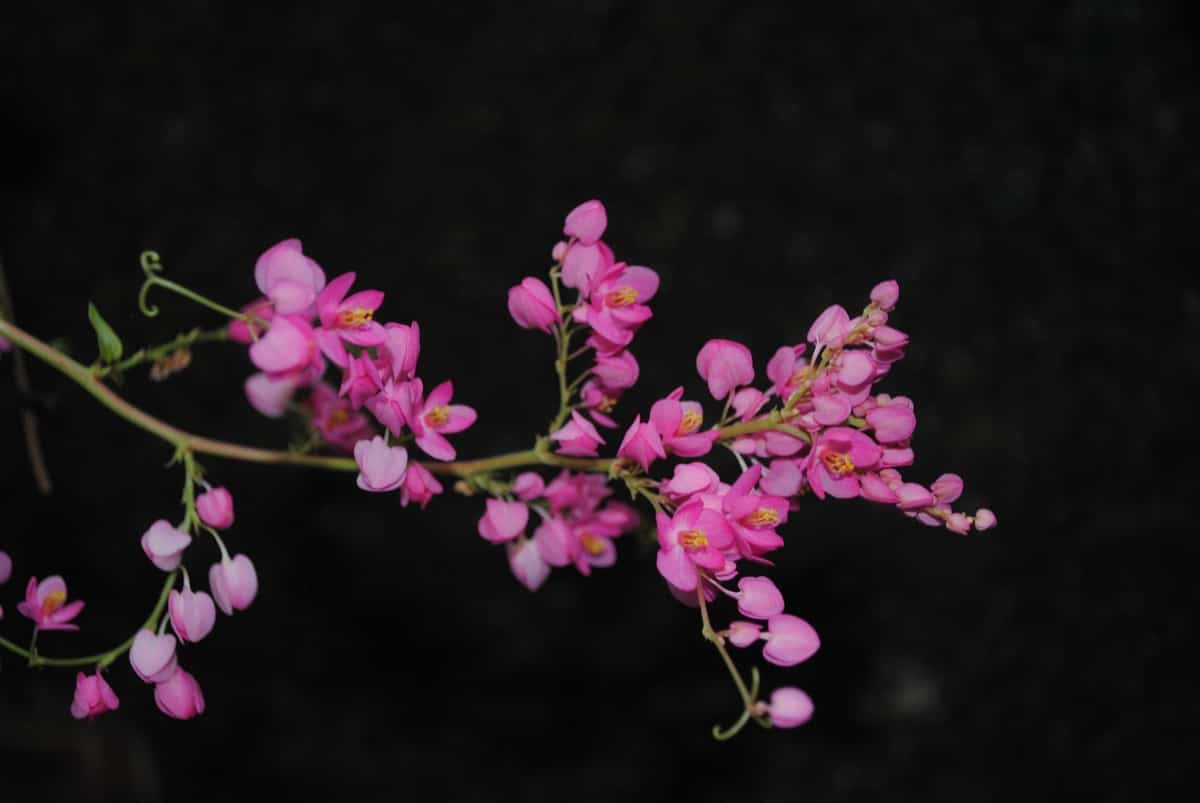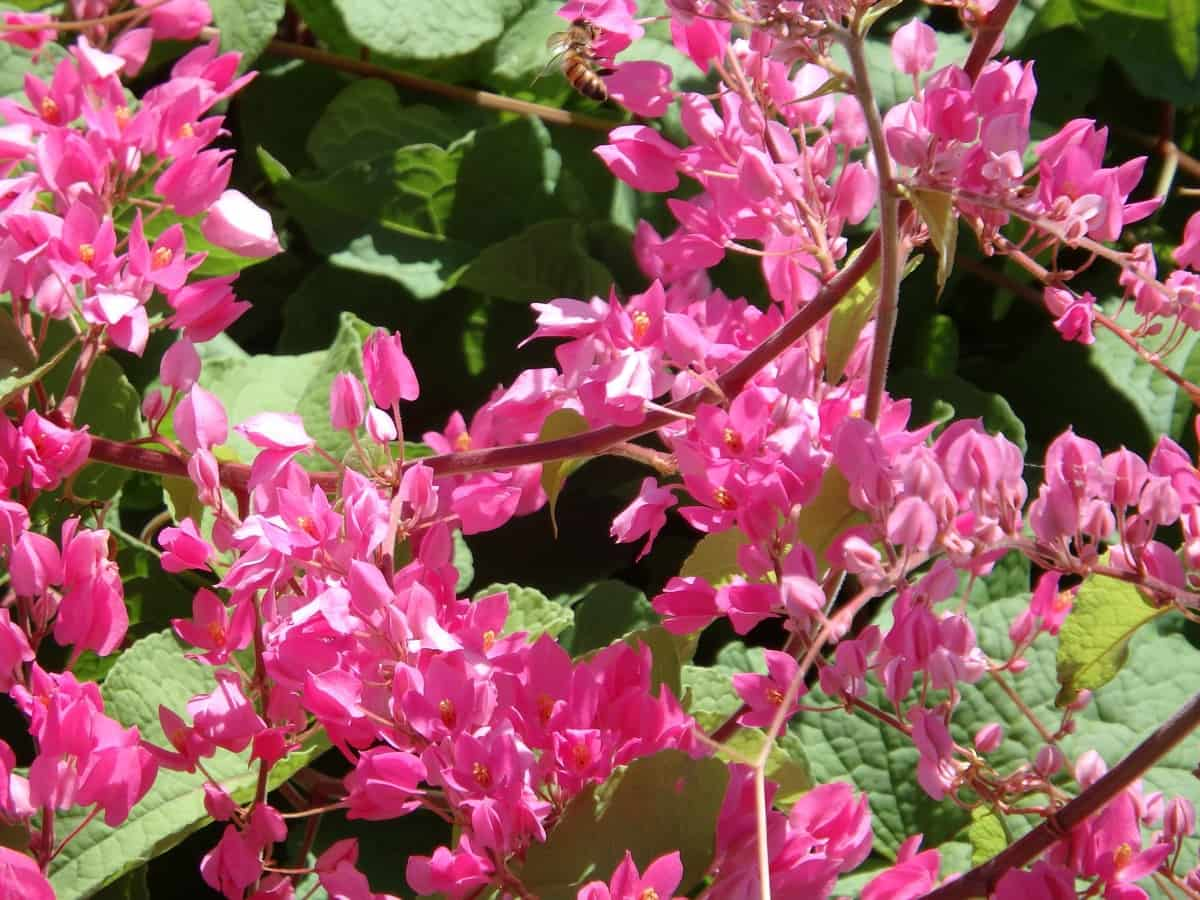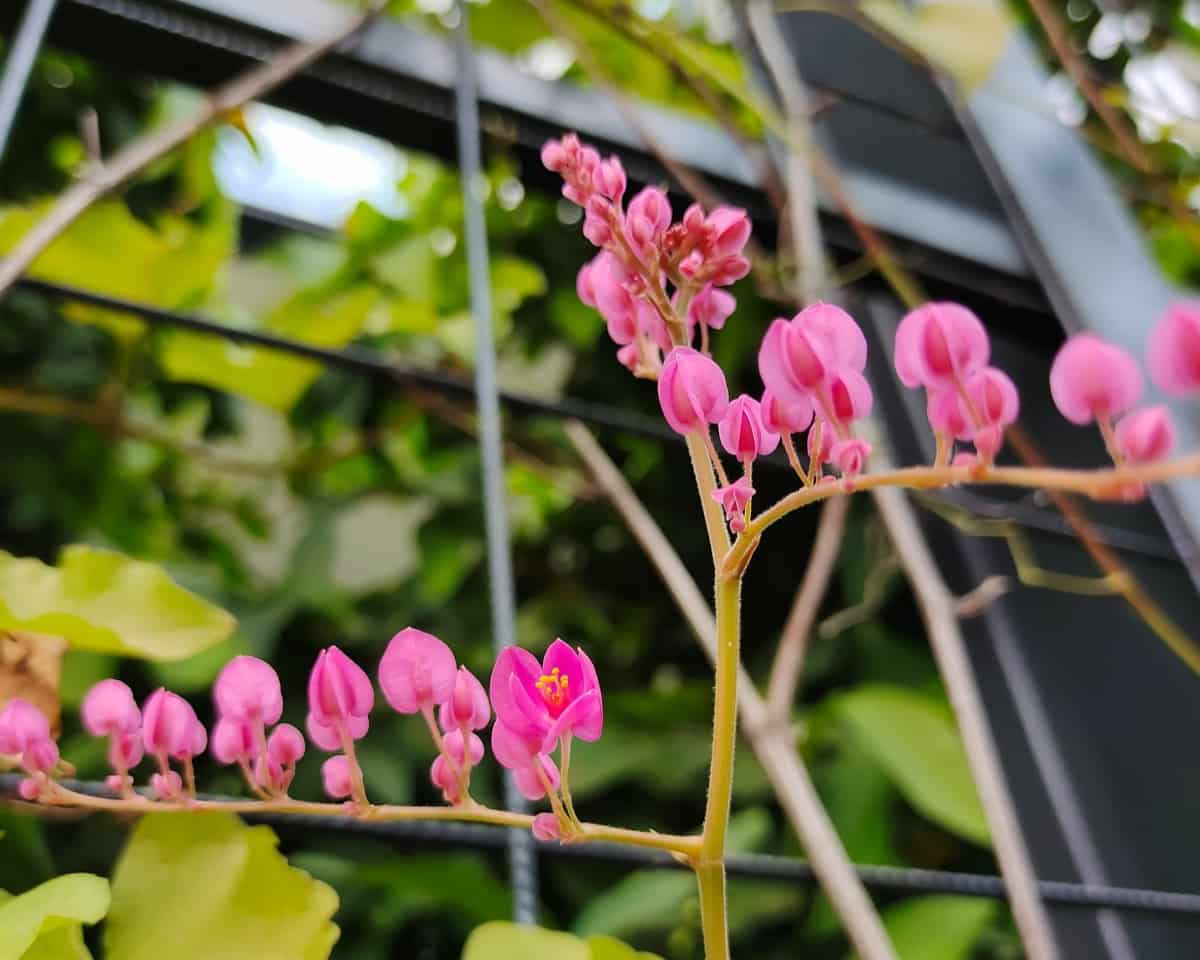Coral Vine is a beautiful and unique addition to any garden. Its bright flowers and twining habit can add color and interest to any landscape. It can grow up to 20 feet long and produce beautiful red, orange, or yellow flowers. Coral Vine is a popular choice for gardens and landscapes due to its colorful flowers and ability to cover fences, trellises, and other structures quickly. The Coral Vine is a beautiful, fast-growing plant that can add color and interest to any landscape.

With proper care, it can be a long-lived addition to the garden. You can use it as a groundcover or spillover plant in hanging baskets and containers. Coral Vine is a fast-growing plant, so it prefers regular pruning to keep it under control. It can be trained to grow up trellises or fences or left to trail along the ground. This vining plant is relatively easy to care for and is tolerant of most soil types and climates.
How to grow and care for coral vine plants (Mexican Creeper)
Climate suitable for growing Coral Vines
Coral Vines thrive in warm climates with plenty of sunlight and little wind. They need well-drained soil and regular watering but don’t like to be too wet. It is a fast-growing vine that can quickly cover an unsightly fence or trellis. Coral Vine is not particular about soil type but prefers a sunny location.
It will also tolerate some shade, especially in hot summer climates. Coral Vine is drought tolerant once established. For Coral Vine to thrive, it must receive six hours of direct sun daily. However, it will tolerate partial shade, especially during the hottest day. If you live in very hot summers, you may need to provide some afternoon shade for your Coral Vine.
In case you missed it: How to Grow Winter Squash and Summer Squash in the USA: Soil, Propagation, Planting, Care, and Farming Tips

Soil requirement for growing Coral Vines
When choosing soil for growing Coral Vines, remember a few things. The first is that the soil should be well-draining. The Coral Vine is a tropical plant that does not like sitting in wet, soggy soil. If the soil is too dense, it will hold too much water and can cause the roots to rot. The second thing to consider is fertility. Coral Vine is a relatively heavy feeder and will need some extra nutrients to thrive.
You should choose soil mixed with compost or other organic matter. This will help provide the nutrients that Coral Vine needs to grow healthy and vigorously. Finally, ensure the soil’s pH is between 6.0 and 7.0. This range is considered ideal for most plants, including Coral Vines.
Water requirement for growing Coral Vines
Watering is an essential part of growing Coral Vines. The plant does best in moist, well-drained soil. Water the plant deeply, then dry it out completely before watering again. This deep watering will help to encourage a deep root system. The Coral Vine is a fast-growing, drought-tolerant plant. It produces clusters of small, trumpet-shaped flowers, typically pink, red, or orange.
Coral Vines need at least 1 inch of water weekly to ensure proper growth and blooming. During periods of dry weather, you may need to increase the watering frequency to twice per week. When watering your Coral Vine, ensure the soil is evenly moistened but not soggy. Allow the top couple of inches of soil to dry before watering again. During the winter, you can reduce the water you give your Coral Vine.
Coral Vine propagation
Coral Vine is an excellent choice if you’re looking for a quick-growing, heat-loving vine. This flowering, evergreen vine grows best in full sun and can quickly cover a trellis or fence. Propagating Coral Vines is easy from stem cuttings, and you can even start the vines from seed.
In case you missed it: Top 25 Flowering Plants that Bloom in Winter

From cuttings
When propagating Coral Vine from stem cuttings, look for healthy stems. Cut the stems at a 45-degree angle just below a node (the area where the leaves attach to the stem). Dip the Coral Vine cutting in rooting hormone powder and plant in moistened potting mix. Place the pot in a warm location from direct sunlight and keep the soil moist but not soggy. Roots should form within 2 to 3 weeks.
Once the roots are about an inch long, you can put up the cutting in the soil. Coral Vine is a fast-growing plant, giving it room to spread out. However, it can be aggressive in some cases, so you should plant it in an area that won’t crowd out other plants. The Coral Vine is typically grown as an annual plant in colder climates.
From seed
To propagate Coral Vine from seed, plant the seeds in moistened potting mix in late winter or early spring. Maintain the soil moisture levels and place the pot in a warm location from direct sunlight until germination occurs (usually within 2-3 weeks). Once the seedlings have emerged, you should thin them so that only one strong seedling remains per pot. Transplant seedlings into larger pots or your garden after all the danger of frost have passed.
Pot size for growing Coral Vine
A small plant will need a small pot, while a large one will need a large one. You should also consider the type of soil you are using. If you are using a soil mix, you will need a larger pot than if you are using a potting mix. If you are growing Coral Vines in a container, make sure there are drainage holes at the bottom so that excess water can escape. Before adding your soil mix, gravel or rocks should be placed at the pot’s bottom. This will help with drainage and prevent root rot.
In case you missed it: Earning 70 Lakhs from Rose Cultivation in 5 Acre Polyhouse: The Success Story of a Flower Farmer

Transplanting Coral Vine seedlings
When transplanting Coral Vine seedlings, it is essential to water them well and keep them moist. They should be transplanted in the spring or early summer. The best time to plant them is when they are young and small. It is also essential to ensure they are not crowded when transplanting.
Be sure to choose a planting site with well-drained soil and full sun. To transplant, dig a hole and gently remove the seedling from its container, taking care not to damage the roots. Place the seedling in the hole, filling it around it with soil. Firmly press down on the soil to remove any air pockets. Water thoroughly.
Coral vine plant care
Coral Vine care in winter
When it comes to Coral Vine care in winter, the main thing to remember is to keep the plant well-watered. Other than that, there’s not much else you need to do. Coral Vine is a tough plant that can withstand cold temperatures and even some snowfall. Just make sure to protect it from extreme conditions, such as strong winds or prolonged periods of freezing temperatures.
If you live in an area where Coral Vine doesn’t go dormant in winter, you can still cut back the plant if you want to tidy it up. You can take cuttings any time of year, but it’s best to wait until late winter or early spring so the plant has time to recover before the growing season begins.
Fertilizer requirement for growing Coral Vine
Coral Vines are beautiful, ornamental plants that can add a touch of color to any garden. But, like all plants, they need the right fertilizer to thrive. If you’re growing Coral Vine for the first time, it’s essential to know how much fertilizer to use. Too little fertilizer will result in poor growth and yellow or pale green leaves.
In case you missed it: Earning 24 Lakh Rupees from Polyhouse Chrysanthemum Cultivation: A Success Story of a Flower Farmer in India

The best way to determine the fertilizer requirement for your Coral Vine is to test the soil before planting. Once you’ve determined the correct amount of fertilizer for your Coral Vine, it’s essential to apply it correctly. You should apply fertilizer evenly around the base of the plant. Water thoroughly after applying fertilizer to reach the plant’s roots where needed most.
Pruning Coral Vine
Pruning Coral Vine is essential in keeping this plant healthy and vibrant. You can prune Coral Vines by cutting the main stems about 6 inches above the ground. You can also remove any dead or damaged leaves or stems as you see them throughout the growing season. If you want your Coral Vine to thrive, you must give it a good pruning now and then. Pruning not only encourages new growth but also helps to keep the plant under control.
Pests and diseases of the Coral Vine and their control
Coral Vine is a beautiful, fast-growing tropical plant that can add a touch of the tropics to your home. But, like all plants, it can be susceptible to pests.
- Aphids are soft-bodied insects that feed on the sap of plants. They can cause stunted growth and deformed leaves. To control aphids, spray them with water or insecticidal soap.
- Spider mites cause stippling (tiny dots) on leaves and lead to leaf drop. To control spider mites, spray them with water or insecticidal soap.
- Powdery mildew is a fungal disease affecting many plants, including Coral Vines. Powdery mildew can weaken the plant and make it vulnerable to other problems, so it’s essential to control it. To prevent powdery mildew, water early in the day to dry before nightfall. If powdery mildew does appear, you can treat it with a fungicide.
- Rust is another fungal disease that can affect Coral Vines. It appears as orange or brown spots on the leaves and stems of the plant. Rust can weaken the plant and make it prone to other problems, so it’s essential to control it. If rust does appear, you can treat it with a fungicide.
- Root rot is caused by too much water around the plant’s roots. The roots will start to decay, and the plant will wilt and die. To prevent root rot, ensure the plant has good drainage and doesn’t over-water it.
- Stem rot is caused by a fungus that attacks the plant’s stems. The stems will become soft and mushy, and the plant will eventually collapse. To prevent stem rot, water the plant at the base and remove any dead or decaying leaves or stems from the plant.
In case you missed it: USA Soil pH Chart: Ideal and Optimum Range for Vegetables, Fruits, Flowers, and Herbs

Conclusion
The Coral Vine is a beautiful ornamental flowering plant perfect for adding color to any garden or landscape. The vine produces many small, brightly-colored flowers attracting bees and pollinators. The leaves are dark green and glossy, providing a lovely contrast to the colorful flowers. With just a little care and attention, your Coral Vine will thrive and enjoy you with endless enjoyment.
- Economical Aquaculture: A Guide to Low-Budget Fish Farming
- 15 Common Planting Errors That Can Doom Your Fruit Trees
- How to Make Houseplants Bushy: Effective Tips and Ideas
- Innovative Strategies for Boosting Coconut Pollination and Yield
- Pollination Strategies for Maximum Pumpkin Yield
- The Complete Guide to Chicken Fattening: Strategies for Maximum Growth
- Natural Solutions for Tulip Problems: 100% Effective Remedies for Leaf and Bulb-Related Issues
- Revolutionizing Citrus Preservation: Towards a Healthier, Greener Future
- Natural Solutions for Peony Leaf and Flower Problems: 100% Effective Remedies
- Maximizing Profits with Avocado Contract Farming in India: A Comprehensive Guide
- Natural Solutions for Hydrangea Problems: 100% Effective Remedies for Leaf and Flowers
- The Ultimate Guide to Choosing the Perfect Foliage Friend: Bringing Life Indoors
- From Sunlight to Sustainability: 15 Ways to Use Solar Technology in Agriculture
- The Ultimate Guide to Dong Tao Chicken: Exploring from History to Raising
- The Eco-Friendly Makeover: How to Convert Your Unused Swimming Pool into a Fish Pond
- Mastering the Art of Delaware Chicken Farming: Essentials for Healthy Backyard Flocks
- 20 Best Homemade Fertilizers for Money Plant: DIY Recipes and Application Methods
- How to Craft a Comprehensive Free-Range Chicken Farming Business Plan
- Brighten Your Flock: Raising Easter Egger Chickens for Beauty and Bounty
- How to Optimize Your Poultry Egg Farm Business Plan with These Strategies
- Subsidy for Spirulina Cultivation: How Indian Government Schemes Encouraging Spirulina Farmers
- Ultimate Guide to Raising Dominique Chickens: Breeding, Feeding, Egg-Production, and Care
- Mastering the Art of Raising Jersey Giant Chickens: Care, Feeding, and More
- Ultimate Guide to Raising Legbar Chickens: Breeding, Farming Practices, Diet, Egg-Production
- How to Raise Welsummer Chickens: A Comprehensive Guide for Beginners
- How to Protect Indoor Plants in Winter: A Comprehensive Guide
- Ultimate Guide to Grow Bag Gardening: Tips, Tricks, and Planting Ideas for Urban Gardeners
- Guide to Lotus Cultivation: How to Propagate, Plant, Grow, Care, Cost, and Profit
- Agriculture Drone Subsidy Scheme: Government Kisan Subsidy, License, and How to Apply Online
- Ultimate Guide to Raising Araucana Chickens: Breed Profile, Farming Economics, Diet, and Care
- Bringing Hydroponics to Classroom: Importance, Benefits of Learning for School Students
- Ultimate Guide to Raising Polish Chickens: Breed Profile, Farming Economics, Diet, and Care
- Ultimate Guide to Raising Australorp Chickens: Profile, Farming Economics, Egg Production, Diet, and Care
- Silkie Chicken Farming: Raising Practices, Varieties, Egg Production, Diet, and Care
- Sussex Chicken Farming: Raising Practices, Varieties, Egg Production, Diet and Care
- Homemade Feed Formulations for Livestock: Discover Cost-effective Starter to Finisher Feed Recipes